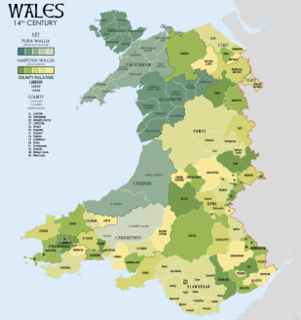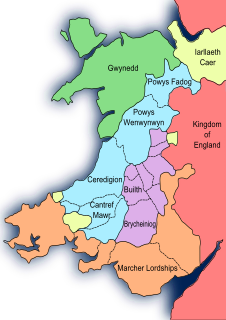Related Research Articles

Prince of Wales is a title traditionally given to the heir apparent to the English and later British throne. Before Edward I's conquest in the 13th century, it was used by the rulers of independent Wales.

Llywelyn ap Gruffudd, sometimes written as Llywelyn ap Gruffydd, also known as Llywelyn the Last, was the native Prince of Wales from 1258 until his death at Cilmeri in 1282. Llywelyn was the son of Gruffydd ap Llywelyn Fawr and grandson of Llywelyn the Great, and he was one of the last native and independent princes of Wales before its conquest by Edward I of England and English rule in Wales that followed, until Owain Glyndŵr held the title during the Welsh Revolt of 1400–1415.
A prince is a male ruler or a male member of a monarch's or former monarch's family. Prince is also a title of nobility, often hereditary, in some European states. The female equivalent is a princess. The English word derives, via the French word prince, from the Latin noun prīnceps, from primus (first) and caput (head), meaning "the first, foremost, the chief, most distinguished, noble ruler, prince".
A style of office or form of address, also called manner of adress, is an official or legally recognized form of address for a person or other entity, and may often be used in conjunction with a personal title. A style, by tradition or law, precedes a reference to a person who holds a post or political office, and is sometimes used to refer to the office itself. An honorific can also be awarded to an individual in a personal capacity. Such styles are particularly associated with monarchies, where they may be used by a wife of an office holder or of a prince of the blood, for the duration of their marriage. They are also almost universally used for presidents in republics and in many countries for members of legislative bodies, higher-ranking judges and senior constitutional office holders. Leading religious figures also have styles.

A Marcher lord was a noble appointed by the king of England to guard the border between England and Wales.
A title is one or more words used before or after a person's name, in certain contexts. It may signify either generation, an official position, or a professional or academic qualification. In some languages, titles may be inserted between the first and last name. Some titles are hereditary.

Through the 5th century Hellenistic political systems, philosophies and theocratic Christian-Eastern concepts had gained power in the eastern Greek-speaking Mediterranean due to the intervention of Important religious figures there such as Eusebius of Caesarea and Origen of Alexandria who had been key to the constant Christianized world of late antiquity.
The Malay language has a complex system of styles, titles and honorifics which are used extensively in Brunei, Indonesia, Malaysia, Singapore, and the southern Philippines.

The Kingdom of Gwynedd was a Welsh kingdom and a Roman Empire successor state that emerged in sub-Roman Britain in the 5th century during the Anglo-Saxon settlement of Britain.

Traditional rank amongst European royalty, peers, and nobility is rooted in Late Antiquity and the Middle Ages. Although they vary over time and among geographic regions, the following is a reasonably comprehensive list that provides information on both general ranks and specific differences. Distinction should be made between reigning families and the nobility – the latter being a social class subject to and created by the former.

The Principality of Wales was originally the territory of the native Welsh princes of the House of Aberffraw from 1216 to 1283, encompassing two-thirds of modern Wales during its height of 1267–1277. Following the conquest of Wales by Edward I of England of 1277 to 1283, those parts of Wales retained under the direct control of the English crown, principally in the north and west of the country, were re-constituted as a new Principality of Wales and ruled either by the monarch or the monarch's heir though not formally incorporated into the Kingdom of England. This was ultimately accomplished with the Laws in Wales Acts 1535–1542 when the Principality ceased to exist as a separate entity.
Owain ap Gruffudd was brother to Llywelyn ap Gruffudd and Dafydd ap Gruffudd and, for a brief period in the late 1240s and early 1250s, ruler of part of the Kingdom of Gwynedd.

Llywelyn's coronet is a lost treasure of Welsh history. It is recorded that Llywelyn ap Gruffudd, Prince of Wales and Lord of Aberffraw had deposited this crown and other items with the monks at Cymer Abbey for safekeeping at the start of his final campaign in 1282. He was killed later that year. It was seized alongside other holy artefacts in 1284 from the ruins of the defeated Kingdom of Gwynedd. Thereafter it was taken to London and presented at the shrine of Edward the Confessor in Westminster Abbey by King Edward I of England as a token of the complete annihilation of the independent Welsh state.
Tywysog, in modern Welsh, means "Prince", but historically it referred to a broader category of rulers. The feminine form is Tywysoges. The work Brut y Tywysogion is the Annals of the Princes of Wales and is a historical narrative of the deeds of the various rulers of the kingdoms, large and small, which existed in Wales from the end of Roman rule in Britain in c.410AD to the final conquest of Wales and the death of its last consecrated native Tywysog Llywelyn ap Gruffudd of Gwynedd in 1282, who was also the first to bear the title Tywysog Cymru. Owain Glyndŵr, Lord of Glyndyfrdwy, and claimed heir to the Kingdom of Powys, was also proclaimed Tywysog Cymru in 1400, but his rule had come to an end by 1412.

King of Wales was a rarely used title, because Wales, much like Ireland, never achieved a degree of political unity like that of England or Scotland during the Middle Ages. While many different leaders in Wales claimed the title of "King of Wales", the country was only truly united under the rule of Gruffydd ap Llywelyn from 1055 to 1063.

In England, the baronage was the collectively inclusive term denoting all members of the feudal nobility, as observed by the constitutional authority Edward Coke. It was replaced eventually by the term peerage.

The history of Gwynedd in the High Middle Ages is a period in the History of Wales spanning the 11th through the 13th centuries. Gwynedd, located in the north of Wales, eventually became the most dominant of Welsh polities during this period. Contact with continental courts allowed for Gwynedd to transition from a petty kingdom into an increasingly sophisticated principality of seasoned courtiers capable of high level deplomacy and representation; not only with the Angevine kings, but also the king of France and the Papal See. Distinctive achievements in Gwynedd include further development of Medieval Welsh literature, particularly poets known as the Beirdd y Tywysogion associated with the court of Gwynedd; the reformation of bardic schools; and the continued development of Cyfraith Hywel. All three of these further contributed to the development of a Welsh national identity in the face of Anglo-Norman encroachment of Wales.
Culture and Society in Gwynedd during the High Middle Ages refers to a period in the History of Wales spanning the 11th, 12th, and 13th centuries. The High Middle Ages were preceded by the Early Middle Ages and followed by the Late Middle Ages. Gwynedd is located in the north of Wales.

The Royal House of Aberffraw was a cadet branch of the Kingdom of Gwynedd originating from the sons of Rhodri the Great in the 9th century. Establishing the Royal court of the Aberffraw Commote would begin a new location from which to rule Wales. The cadet branch achieved the recognised titles of Prince of Wales, King of Wales and were sometimes named King of Aberffraw.

The conquest of Wales by Edward I took place between 1277 and 1283. It is sometimes referred to as the Edwardian Conquest of Wales, to distinguish it from the earlier Norman conquest of Wales. In two campaigns, in 1277 and 1282–83, respectively, Edward I of England first greatly reduced the territory of Llywelyn ap Gruffudd, and then completely overran it, as well as the other remaining Welsh principalities.
References
- The Welsh King and his Court, University of Wales Press (2000), edited by Thomas Charles-Edwards, Morfydd E. Owen and Paul Russell, p. 19 & 27 (Prolegomena to the Laws of Court, by Dafydd Jenkins).